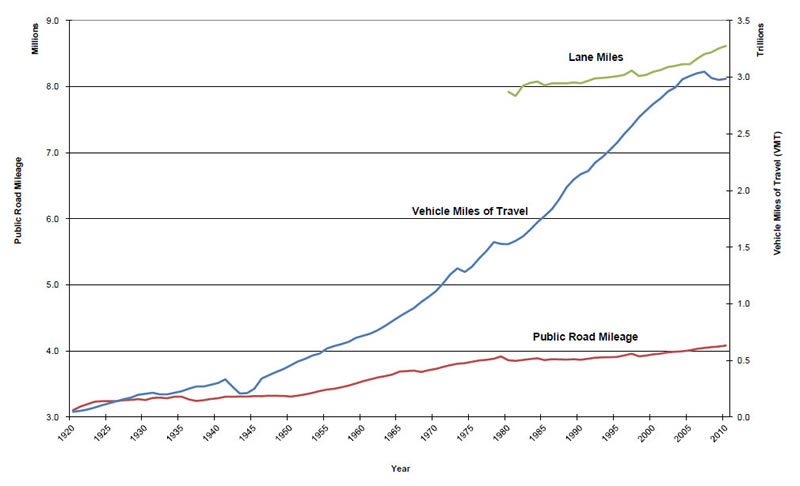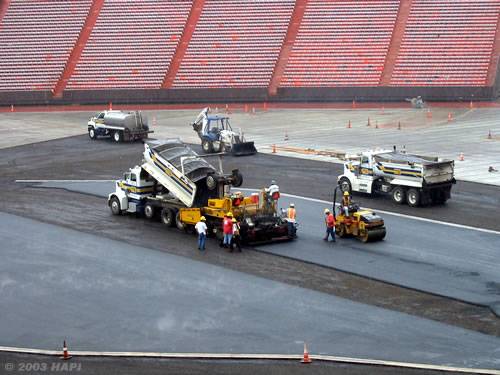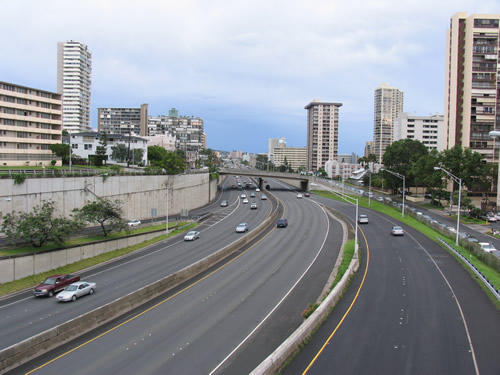Pavement Facts
There are over 4 million public centerline road miles (8.48 million lane miles1) in the U.S. and of this, 2.73 million miles (or about 67 percent) are paved (FHWA 2009). This section contains several quick pavement facts that serve as a good basic background for the rest of the Guide.
Pavement Purpose
Typically,
pavements are built for three main purposes:
- Load support. Pavement material is generally stiffer than the material upon which it is placed, thus it assists the in situ material in resisting loads without excessive deformation or cracking.
- Smoothness. Pavement material can be placed and maintained much smoother than in situ material. This helps improve ride comfort and reduce vehicle operating costs.
- Drainage. Pavement material and geometric design can effect quick and efficient drainage thus eliminating moisture problems such as mud and ponding (puddles).
Pavement Categories
Pavements can be broken down into two broad
categories:
- Flexible pavements. These are asphalt pavements (sometimes called bituminous pavements), which may or may not incorporate underlying layers of stabilized or unstabilized granular materials on a prepared subgrade. These types of pavements are called "flexible" since the total pavement structure bends (or flexes) to accommodate traffic loads. Flexible pavements comprise about 94 percent of U.S. paved roads (about 98 percent of Hawai'i roads).
- Rigid pavements. These are portland cement concrete (PCC) pavements, which may or may not incorporate underlying layers of stabilized or unstabilized granular materials. Since PCC is quite stiff, rigid pavements do not flex appreciably to accommodate traffic loads. Rigid pavements comprise 6 percent of U.S. paved roads (about 2 percent of Hawai'i roads).
Hot Mix Asphalt (HMA) Defined
Hot mix asphalt (HMA) is a bituminous concrete made principally
from asphalt
binder and aggregate.
It is distinguished from other bituminous products by its
constituent materials
(asphalt
and aggregate), mixture
design methods and elevated mixing
temperature (thus the term "hot mix"). Although
it is known by many different names such as hot mix, asphalt
concrete
(AC or ACP), asphalt, blacktop or bitumen, this Guide makes
a conscious effort to consistently refer to this material
as HMA. Other types of asphalt-based pavement surfaces
discussed in this Guide such as fog
seals, slurry
seals and chip seals are
not HMA but are nonetheless important to the pavement industry. Warm mix asphalt (WMA) is essentially the same material as HMA except that a special procedure, additive or material(s) have been used to reduce mixing temperate. WMA is considered a subset of HMA in this Guide.
[More
information]
Tar vs. Asphalt
Tar and asphalt are two different materials. Tar, often
called "coal
tar" is a byproduct of the destructive distillation
of wood or coal to form coke. Coal is of plant origin and was formed
in
swamps similar to present-day peat bogs and in lagoons,
probably partly from plants growing in the area and partly
from plant
material carried in by water and wind. Asphalt is a petroleum residue left
over from the distillation of crude oil. Crude oil is the
result
of incompletely decayed ancient plant and animal remains.
The carbon chains within tar are, in general, slightly
shorter than those in asphalt. In pavement applications,
tar is generally
more brittle and less elastic than asphalt causing it to
crack
under typical loading and environmental conditions. Tar
will, however, not dissolve as easily in the presence of
lighter
petroleum distillation products such as gasoline and kerosene.
While asphalt is used throughout the pavement industry,
tar is generally limited to sealant use. Coal tar sealant is coming under increased scrutiny and has been banned in many areas because of its association with polycyclic aromatic hydrocarbons (PAHs) found in streams and parking lot dust reported in research (e.g., Van Metre et al. 2009; Watts et al. 2010; Mahler et al. 2012).
Road Use
U.S. and State roads are being used at an ever increasing
rate. Although U.S. road centerline miles have only increased
by
about 10 percent since 1960, U.S. registered vehicles
have increased by over 300 percent and vehicle miles traveled
have increased by more than 400 percent over that same
time. In sum, our road network, which has not significantly
expanded
since 1960, is now carrying over 4 times the number
of
vehicles. Moreover, truck (the most damaging type of
vehicle) vehicle
miles traveled (VMT) is increasing at an even faster
rate than automobile VMT. A typical tractor-semi trailer combination
averages 100 - 200 miles/day in the U.S. for a total
of
35,000 - 70,000 miles/year, which is substantially more
than the
typical
passenger vehicle (USDOT, 2000). Thus, pavement loading
is growing at an even faster rate than traffic.
| HAPI Pavement Note on Hawai'i Road Use |
Hawai'i has 4,371 centerline miles of roadway (9,523 lane-miles1). As of 2012, Hawai'i's population was just under 1.4 million and of that about 1 million (or 75%) were of driver age with about 890,000 licensed drivers and over 895,000 registered vehicles. These vehicles traveled approximately 9.973 billion miles in 2009 (the lastest data year at the time of this publication) at an average of just over 11,000 miles per vehicle (7,254 miles per capita). Of note, that is about 1,000 miles more per vehicle than was reported in 2001.
|

Figure 2: Growth of vehicle miles traveled (VMT),
registered vehicles and
statute miles of roadway in the U.S. since 1960 (from FHWA
2010).
Other Pavement Uses
HMA is used in many applications beyond roads. HMA is by far
the most popular airfield
pavement (about half of all major airport runways are surfaced with HMA while well over 90% of all airport runways are surfaced with HMA) and can also be used in drainage
swales, retention pond and reservoir applications
as well as other specialty applications (see Figure 3).

Figure 3: Paving the base layer for the field turf installation at Aloha Stadium.
Figure 4: Paving at Honolulu International Airport.
Note 1: A centerline mile is based on a road's physical length regardless of the number of lanes. A lane mile is based on the total length of lanes. For instance, a 1 mile road with four lanes would constitute 4 lane miles.



